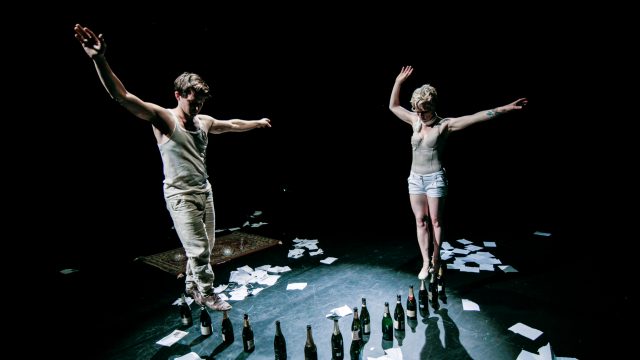Review from: Assembly Roxy, Edinburgh Festival Fringe; 12th August 2018

Classic jazz. A 1970s TV. An upright piano and stool. A wooden-backed chair. A man in the chair (David Carberry), arms shaking, fingers shaking, mouthing… almost mouthing. Static on TV. This is not the commercial Company 2 of Scotch & Soda, but does keep all its beautiful attention to detail in an existential expression of profound distance between two people, inspired by excerpts from Fyodor Dostoyevsky’s Notes From Underground.
Behind gauze, a hula hooper (Alice Muntz). Shadow and light. Swirling skirt of lace and ringlet curls of hair. The Man tries to inch his way into her circle of safety, the hoop acting as a boundary from intimacy. She allows him close, but keeps her private circle spinning as he lifts her from the ground into 2-high and back. Courtship.
Breaks into new mode. She with papers, crumpling and scrunching, as he physically reacts with the sound. She hands him a note, then Music Mode again.
Crackly record player piano. They dance together, lifts and acrobatic steps, hand in hand. The passion, and its loss.
Through gauze, a typewriter table. The man approaches. Text types out on TV screen, philosophy of happiness and advantage. Typing sound rhythms are interesting in themselves, words secondary.
He moves to the piano. Gauze falls. She is on doubles trapeze, alone, her movement quality consistent with her ground-based self. She is alone, trapped in something with a disinterested, distracted man. Paws papers with her pointed feet as they reach the ground.
The silence = the story
She reads a letter into a microphone, dragged away again and again, along with her hope that he’ll return. He disrupts on upright piano, hammers and strings visible.
Music style is more recent now: music hall tinkling with record player crackle. A return to the dance duet now has both more violence and more tenderness, familiarity grown over time. Choreographic development between sections is satisfying. Heartbeats intrude into the sound.
Crackles and static occur between the ambient acted sections and the musically accompanied movement segments.
The man is lying on the floor, trousers raised stiff around the crotch. Spotlight. Wordless attempts at defence, whose emotions come out in physicality instead. Glass bottles roll on. Keep coming. She sits, hugging her musical instrument – a harp? – close to her chest.
They meet, tentatively, atop lines of glass bottles. The fragility of the relationship perfectly captured.
I see the relationship with an addict, an obsessive. When he’s charming, he’s so charming; when he’s preoccupied he is cruelly distant and neglectful.
A disappearing lady table. The man is still playing his guitar in experimental poses. Self-absorbed fellow. She locks herself away. The metaphor of her enabling herself to be cut in half has powerful resonance. Others are chuckling while I have tears on my cheeks at her emotional abandonment.
He comes downstage and sings to us, as if a bar-room gig. ‘Be sure it’s true when you say I love you’. Music hall quality is back. She should never have let her hula hoop go 🙁
The show has crafted really sensitive use of music and silence. I want the TV to come back on again… and it immediately does!
The pair have strong trapeze game in service of expressing internal conflicts and a restless mental state. The bar is lowered to a yard from the floor for diving and further solo choreography (Chelsea McGuffin is credited as choreographer, alongside Carberry’s concept and direction, with Muntz as a co-creator). Was he meant to fall from attempted backtuck-to-toehang? Seems like yes from the slickness of continuity. A sense of failure fits.
Recorded radio philosophy. Sand poured from a shoe. Now it’s the man that has a small circle that she can’t fully inhabit. Sorrowful and resigned. With tap shoes on sand, his obsession is revealed as a search for truth. Abruptly, it ends.
.




